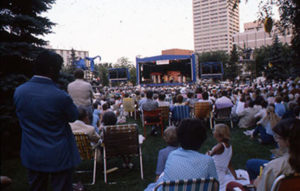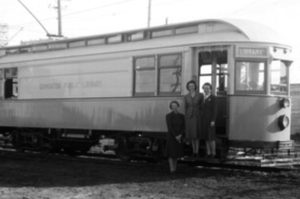“The end of the 19th century and the beginning of the 20th century were driven by the wonder of electricity, new transportation and communication technologies. And the face of the city began to change a bit.”
Historian Ken Tingley is sure right about that. And he tells the story of the role Edmonton’s transit system played in those changes in his 2011 book, “Ride of the Century.”
Edmonton became a city in 1904 and just four years later its electrically powered streetcars started to roll.
“When they finally got it done they were proud as punch. It was the most northerly rapid transit, let’s call it, in North America and they boasted of that,” says Tingley.
Boasting didn’t bring a smooth roll out though.
“That system always had problems. They had a dry run on October 30, 1908 and everything went wrong,” writes Tingley. “They didn’t get out of the Syndicate [Avenue] garage (the site of what is now Giovanni Caboto Park) until the evening. It was getting dark and people were waiting. And then the streetcar broke down. There was a carload of ladies stuck out in the dark. They enjoyed it. They were singing away. Then on the 31st they had their first official run. They actually had no official opening because by the time they would have gotten around to the official opening, they’d had so many problems.”
Tingley says that the first streetcar finally did get running pretty much on schedule, but then as winter approached, there were more glitches. The cars were jumping the rails at times because of extreme temperature changes.
And what’s more, those streetcars were uncomfortably cold: ”Winter was coming on and they heated it with these little stoves at the front of the streetcar. Part of the motorman’s job was to get there really early and get a really hot fire going for the patrons.”
And problems with the power supply persisted as the electrical plants struggled to cope with the demands of the new public transit system. But Tingley says it became pretty serviceable.
“There was an extensive system that ran across the bridge and up Mill Creek Ravine to Whyte Avenue. And then on from Whyte Avenue. It served quite a wide area,” recalls Tingley. It was called the Radial Railway because it had a nucleus, a centre with lines radiating out from it.
A big problem was the river valley. That, of course, is because it’s pretty steep. But Tingley says there was a workaround. “They had to use a lot of sand on the grades until the High Level Bridge brought things in at a level. It turned out to be a very good system.”
But it didn’t last. By 1951, the streetcars were gone and diesel powered buses replaced them. And more and more automobiles filled the streets of a growing city. That brought different problems.
“Crowding is not necessarily the result of too many citizens. A small city can be more congested than a large one. ‘Crowding’ means that the citizens have arranged something, usually their traffic, stupidly. Today what complicates and multiplies the age-old problem of urban congestion, of course, is the motorcar, which uses nine times as much space as a human being takes on a public conveyance and while parked, takes as much space as an office.”
Those words are from an article by Gilbert Burck. They were about Chicago, but they resonated in Edmonton in the early 1960s. In those days Edmonton was starting to see more traffic congestion and limited parking downtown. People like then Edmonton Transit Superintendent Don MacDonald saw light rail transit as a solution. And he is credited with getting city council on board with the idea.
It took a lot of planning, with numerous route options considered, and a huge amount of construction work once the route was decided on. But by April of 1978, Edmonton’s first Light Rail Transit line was running, well in time to carry all the people who would be heading to the brand new stadium for the Commonwealth Games held in August of that year. And, like back in 1908, there was some reason for puffed out chests.
Edmonton was the first city in North America with a population under a million to build a light rail transit system. At first, it had just five stops, with the Central, Churchill, Stadium, Coliseum and Belvedere stations. Then, more and more stops were added to what is now the Capital Line. And in 2015 the Metro Line opened, carrying people from Churchill Station to NAIT. Eventually it will continue further northwest.
Now the evolution of Edmonton’s public transit continues with the Valley Line LRT. The first part, the southeast leg, opens in 2023. The 12-stop southeast line runs from Mill Woods to 102 Street downtown Edmonton. Phase two of the Valley Line will carry on to Lewis Farms in the west. It’s a much different look with a low-floor system designed to be a better fit with the neighbourhoods it goes through.
And Ken Tingley sees similarities with Edmonton’s streetcar past:
“We’re sort of back where we were. We had trolleys until 1951 with overhead wires and tracks. Then we went to all gas bus fleets. Now we’re right back to the same thing. We have the LRT with overhead wires and it runs on rails. It’s very similar.”
Related Stories
Churchill Stop













